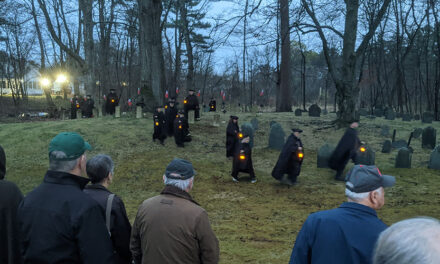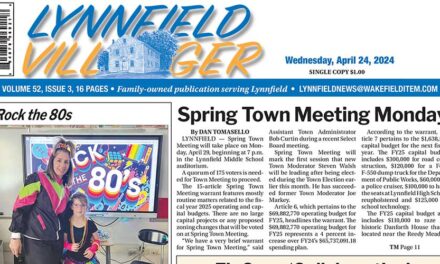Published in the April 5, 2017 edition
By BOB BURGESS
LYNNFIELD — In a preview of a debate looming on Town Meeting floor in a couple weeks, supporters of constructing a rail trail laid out reasons why a four-season linear recreational path would be good for the town, while opponents had questions about, among other things, unforeseen costs, protecting abutting properties and the lack of adequate parking for outsiders.
Supporters of the rail trail made it clear at the March 30 public forum held at the middle school that the April 24 Town Meeting is only being asked to show the town is ready to move forward in the process so no already-pledged federal and state funding for the project will be jeopardized. The rail trail project, which includes part of Wakefield, is slated to receive about $7.1 million in Department of Transportation funds.
No money is being requested from the coming Town Meeting, so only a majority vote would be needed to pass warrant Article 24.
The Friends of the Lynnfield Rail Trail hosted the forum, which included several speakers and then a question and answer period. The forum was moderated by Main Street resident Steve Fantone.
Vince Inglese of the Friends of the Lynnfield Rail Trail said the rail trail project is a “once in a lifetime opportunity,” and if the citizens’ petition article is passed at Town Meeting, the town could see a 2.5 mile four-season recreational path running from Reedy Meadow to the Peabody line by 2020.
Inglese pointed out that 107 communities — among them the most desirable to live in the commonwealth — have already voted to support rail trails within their borders. The most recent is Dover. He continued that there is “widespread support” for a rail trail among Lynnfield residents. In fact, a multi-purpose fitness track was the most requested recreational need in town in a recent survey.
The rail trail, proposed to be built on an old train line owned by the MBTA, would only cross two of Lynnfield’s streets — Summer Street and Pillings Pond Road. It would run behind the middle school and the high school, conveniently connecting the two educational facilities.
The trail would run through Reedy Meadow for about seven-tenths of a mile on low maintenance decking material built on pilings and would include fencing, Inglese said.
He said the trail would increase safety (by getting recreationalists and others off the town’s main streets), would provide year-round access and recreation for all ages and abilities, would increase property values, would increase the general health and wellness of Lynnfield residents and would help build social connections among those who use it.
It also would provide a safe route for many students to get to and from school. Rail trails have been used as outdoor classrooms, Inglese said, and would provide an excellent athletic resource for Pioneer sports teams.
The cost of the project, which would run from Main Street in Wakefield near the state-of-the-art Galvin Middle School to the Peabody line, has already been earmarked by the state Department of Transportation at $7.1 million. The two towns, Inglese said, would have to pay for the design of the path. State lawmakers have already secured $530,000 for that. Anything else would have to be raised privately.
According to the Rails to Trails Conservancy, an asphalt surface costs just under $2,000 a mile to maintain. At some point, the trail would need improvements like repaving and upgrades to the boardwalk through Reedy Meadow. Inglese said money from the state Department of Conservation and Recreation has paid for these types of improvements on other rail trails in the commonwealth.
Police Chief David Breen wholeheartedly supports the project, Inglese said, in part because statistics show such recreational paths do not increase criminal activity where they currently exist. The Lynnfield path would be open from dawn to dusk, and would be patrolled all the time by Lynnfield Police, Inglese said.
“This is a fiscally responsible project that will enrich the lives of all in Lynnfield,” Inglese concluded.
Among the guest speakers was Craig Della Pena, a resident of the Florence section of Northampton and someone described as an “expert” on rail trails. Della Pena also is a Realtor who specializes in selling properties next to greenways like rail trails. In fact, he lives eight feet from one and is a huge proponent of them.
Della Pena said a lot of people use the trails, and through a series of slides, showed trail users on motorized scooters, in wheelchairs, mixing with others and clearly enjoying being outdoors.
He mentioned a project in Natick, where residents are being asked to raise $6 million to buy property from freight carrier CSX to build their trail. “Yours,” he told Lynnfieldians at the forum, “is virtually free.”
He said millennials buying homes are “amazed” that people are opposed to rail trails. Della Pena said young people look to live in “functioning” communities with sidewalks, porches, traditional neighborhoods and downtown businesses they can walk to.
Citing a study, Della Pena said homes near rail trails around the country sell in an average of 29.3 days, as opposed to 50 days for those not near a rail trail.
Underhill Road resident Tom Grilk would be an abutter to the rail trail, and he told the audience he is all for it. The executive director of the Boston Athletic Association, organizers of the Boston Marathon, Grilk is a fitness enthusiast himself and uses rail trails all over the world. He said he was recently in a German city and residents there take great pride in their recreational path, which they use to get around their community.
Getting out the door and getting fit, Grilk said, is a pretty good thing. “For me, I’ll just have to go out my back door” to use the proposed trail. “And I welcome having people out there.”
Grilk said when he first moved to Underhill Road he would run alongside the train tracks. He did this, he said, until the railroad expanded the tracks, which it abandoned using not long after improving.
“We will all be the better for it,” he said of the proposed recreational pathway.
Two members of the Friends of the Danvers Rail Trail spoke about their experiences. The Danvers path is so popular, Charlie Lincicum said, that the town is looking to expand it to the west connecting various public facilities to St. John’s Preparatory School.
In 2009, Lincicum said Danvers finally got to lease MBTA land for $1, which is exactly what the Friends of the Lynnfield Rail Trail are looking to do. Before the Danvers trail was built, Lincicum said the roughly 225 abutters to the property expressed concerns about safety. Today, those concerns are gone, replaced by the occasionally straying dog and the fact the 4.3 mile Danvers path isn’t paved yet.
There has never been a violent crime on the Danvers trail, Lincicum explained, adding, “the more people you can get on the trail the safer it is going to be. All those extra eyes is what makes it safe.”
The Danvers rail to trail committee members do a lot of the maintenance projects along their path themselves, such as mowing, cutting back brush and picking up trash. They also rely on a lot of community service from students and through various Eagle Scout projects.
Locksley Road resident Patrick Curley explained the actual Town Meeting warrant article. He said supporters of the rail trail were asking voters to authorize the selectmen to executive a lease of up to 99 years for the old MBTA rail line.
The Town Meeting vote, Curley said, is not binding the town to build the rail trail and it doesn’t ask for any money.
What it does do is show the state that Lynnfield is serious about having a future rail trail, that the town is ready to advance on the design of the trail without “needless delay,” and improves the town’s “readiness factor.”
“This is your opportunity to push (the project) forward,” Curley said.
During the question period, a resident asked where the town will get the money for continuing to fund the planning stage of the trail. He was told that the state Department of Transportation has grants available and there would be private fundraising done.
Another resident asked Della Pena about the fate of a rail trail in Williamsburg, located just north of where Della Pena lives. National Grid eventually owned the property and several adjoining landowners sued the utility saying the property was theirs. What happened in the end, Della Pena said, is that 22 landowners “got bigger, better backyards.”
Eventually, one of the landowners sold it to a woman who thought a rail trail made sense, so she sold the land to a rail trail advocacy group. Today, it is part of a plan to connect Boston to Northampton via rail trail.
The same questioner asked about the results of a recent online Master Plan survey.
Randy Russell of the Recreational Path Committee, a subcommittee appointed by the Board of Selectmen to evaluate potential recreational paths in town and provide recommendations to the board, told her about 600 people took it, and of those, a rail trail was favored by about a 2-1 margin. Of those residents abutting the proposed trail, it was favored 55 percent to 44 percent.
A new Parsons Avenue resident asked how his privacy could be assured since a future rail trail would go right by his house.
He was told that at a meeting in November, representatives of World Tech Engineering, the consultant working on the Lynnfield project, asked all abutters to let them know what type of screening or vegetation they preferred along the path. The Parsons Avenue resident was told to get in touch with World Tech.
This led a couple of other residents to say they have tried several times to contact World Tech and never received a reply.
Another woman, referring to the proposed trail as a “tourist trap,” said there’s no place for out-of-towners to park.
Vince Inglese answered that people would park at the middle and high schools, Town Hall, Jordan Park and the Reedy Meadow Golf Course lot.
Charlie Lincicum of the Danvers rail trail committee said most people using the trail in his community walk or ride their bikes to it.
Another resident asked about the cost of added police patrols and whether there would be insurance costs.
Patrick Curley, who is a lawyer, said a policy with a one-time premium of about $35,000 would probably be sought.




